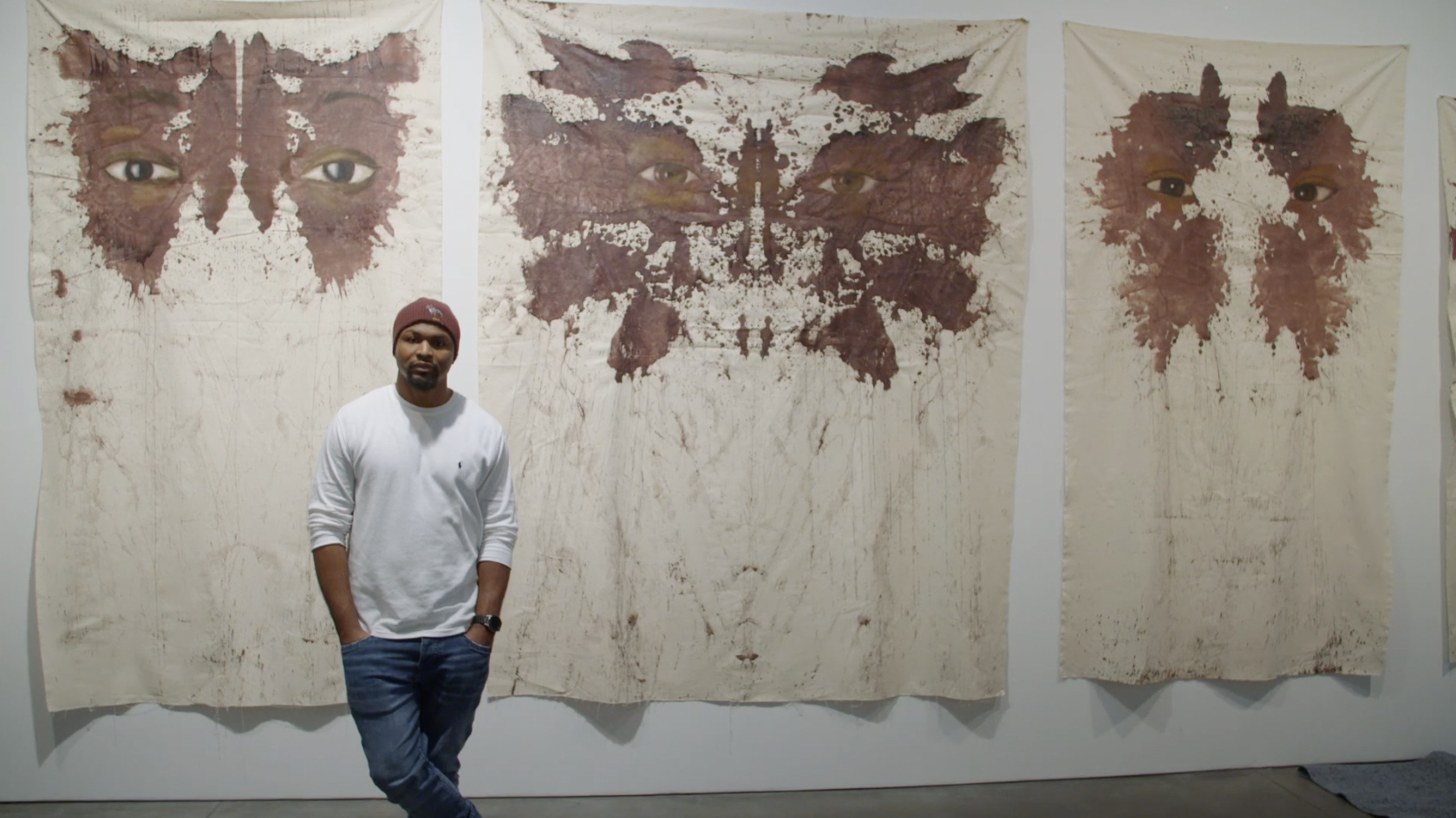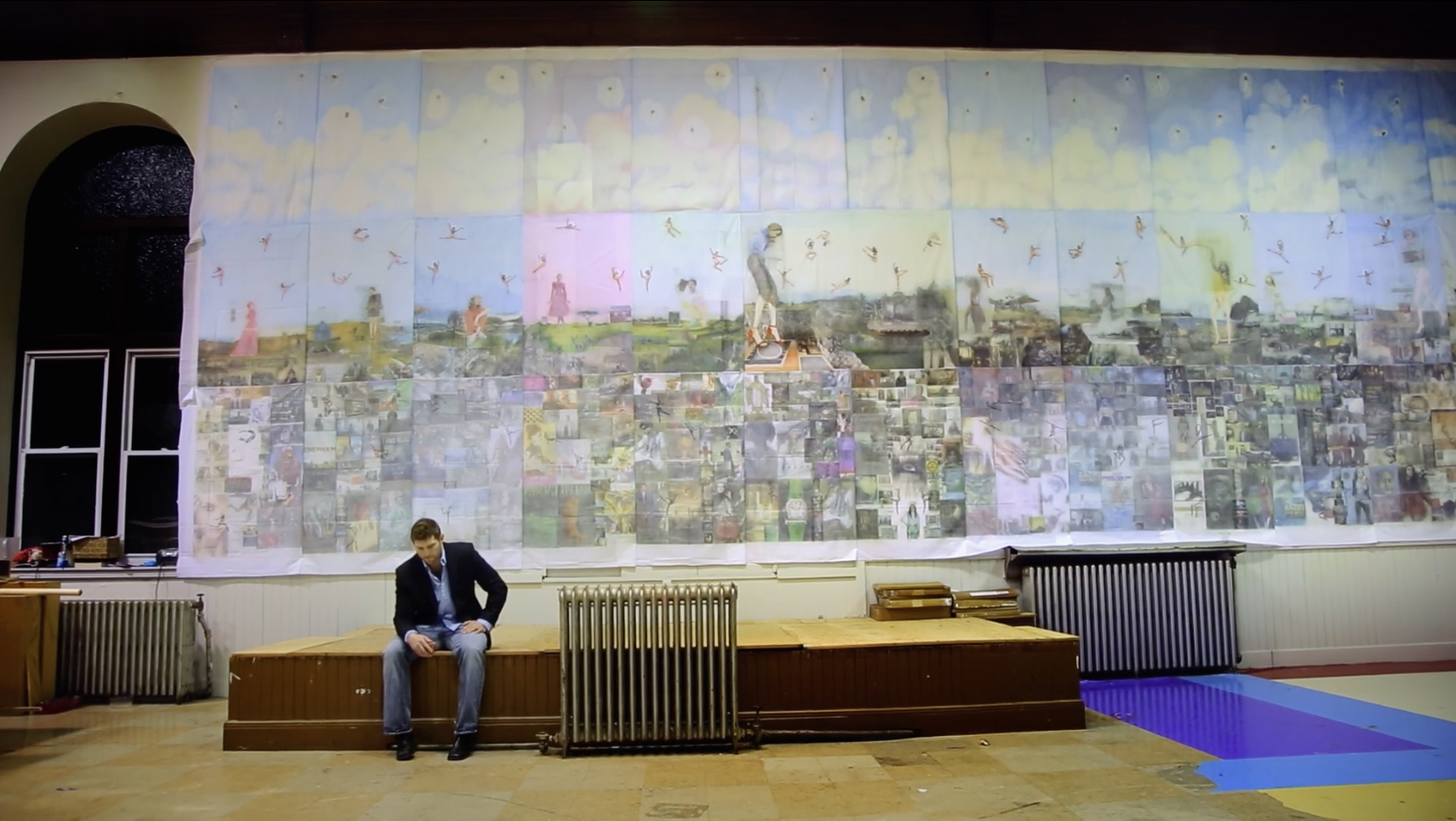On March 22, Inquest cohosted a screening of the film Art & Krimes by Krimes at the Harvard Art Museums. For close to eight years, filmmaker Alysa Nahmias followed formerly incarcerated artist Jesse Krimes, who is now an internationally celebrated contemporary artist. The film shows how even with exceptional talent and lucky connections in the art world, Krimes nonetheless struggled to make a living following his release from federal prison, his record blocking him from job after job—all while living under the threat that if he were deemed to be in violation of his release conditions, he would be returned to prison for a lengthy sentence.
Krimes attended the film screening, and afterwards he participated in a panel discussion alongside Russell Craig, another formerly incarcerated artist who is featured in the film. Krimes and Craig met one another in Philadelphia soon after being released, while installing public art with Mural Arts Philadelphia. Krimes and Craig would go on to found Right of Return USA, which each year awards $20,000 fellowships to six formerly incarcerated artists, giving them the support and space to launch their careers. Previous fellows with Right of Return USA, now in its fifth year, have gone on to win Art for Justice fellowships, Creative Capital awards, Guggenheim fellowships, MacArthur “genius” grants, and the Pulitzer Prize.
In conversation with Inquest founding editor Premal Dharia and Harvard Art Museums curator Makeda Best, Krimes and Craig discussed the challenges faced by formerly incarcerated artists, and how starting Right of Return USA has impacted their own artistic practice. The transcript below has been condensed and edited for clarity.
Makeda Best: The film is your story, Jesse—but it is also about friendship, and the artistic process, and about creating an incredible resource, Right of Return USA, for other formerly incarcerated people. What was it like to make this film?
Jesse Krimes: In the most straightforward sense, the film is about my life, and to have it captured on a screen was personally helpful for me to be able to see my own growth. Through the film I can look back now and see my discomfort in my own skin when I first came home, and how that was shed gradually over the course of the eight years we were filming. In this way the film captures something important about the way incarceration affects how we think about ourselves. But it’s also rewarding to see the impact it has on audiences, by making them aware of these issues. The film has also had a big effect for the formerly incarcerated artists in the film, myself included, in terms of the interest it has generated in our work. It has done a lot to raise our profiles.
It was apparent to me when I was inside that there are so many talented people in prisons whom no one is paying attention to. Most people aren’t even aware that they exist. To be clear, the artists featured in the film are not the exception but rather the norm. There are so many incredibly talented people who have been locked away in cells for decades. When Alysa initially approached me about making the film, I was hesitant, but I really appreciated her thoughtful and collaborative approach to filmmaking and felt a sense of responsibility to tell that story. Because at the time, I was getting opportunities to show my work and I was often the only formerly incarcerated artist in exhibitions about mass incarceration. As a white man, I knew that was not reflective of the carceral state and the people it predominantly impacts, and participating in Alysa’s film felt like it would be a way to actually talk about the reality of the situation.
More from our decarceral brainstorm
Every week, Inquest aims to bring you insights from people thinking through and working for a world without mass incarceration.
Sign up for our newsletter for the latest.
Newsletter
MB: How has your social justice work impacted your art practice?
Russell Craig: Running the Right of Return USA fellowship has definitely affected my personal work. Jesse and I have been blessed to have had the success we’ve had as artists. But the fellowship puts a certain kind of positive pressure on me, for two reasons. One is getting to see how I’ve inspired people, which makes me more aware of the fact that I’m not only making work for myself. But also getting to be part of a community of artists who take their work really seriously, doing research that then gets incorporated into their art—and they want to bounce ideas off of me. So I’m both watching over people and being inspired by them, and always it adds this additional layer of seriousness.

JK: It’s so important to be around other artists who’ve had the experience of being incarcerated. So many of the Right of Return USA fellows have been denied decades of artistic community. They’ve been denied decades of community in general. So when we work with our fellows, they haven’t had access to the Internet, let alone resources to learn how to write an artist’s statement or apply for grants. So they’re functioning with this very serious lack, within the context of an art world that puts up a lot of barriers to access anyway. Artists struggle, period. Add to that, then, the struggle of returning home after the experience of incarceration. That framing is really important to understand. Because what we’ve done with the fellowship is created a community that uplifts people out of that lack of experience to the top of the art world.
Premal Dharia: The film shows how art can be a tool for building community inside of prison. The Right of Return USA fellowship is such a natural extension of that, continuing to build community on the outside. Since the conclusion of filming, how has the fellowship grown, and where do you see it going in coming years?
JK: It feels like in the United States we’ve arrived at a tipping point where, thanks to the work of so many amazing advocates, scholars, and funders, more people are paying attention to mass incarceration. And with that has come a lot more avenues for supporting the kind of work we’re doing. Soon we’re going to be able to go beyond just funding the fellowship and offer expanded programming. Currently we’re in the process of turning Right of Return USA into The Center for Art and Advocacy, which will consist of a three-pronged approach to supporting formerly incarcerated artists at every stage of their artistic career.
A lot of the people who apply for the fellowship are incredible artists—but they don’t have websites, don’t know how to apply for grants, and just basically show these signs of having lacked mentorship and artistic community. And the art world is the art world: There’s a particular language that people look for in applications, and there’s a particular kind of résumé that people expect. This feels like a skills gap we can help to address. Because often all it takes is for someone to actually give a shit and ask, like: Have you thought about this? Or: Your work is touching on these things, you should read this book. Maybe you should look at this artist. It doesn’t take much, just a little bit of genuine care and kindness and interest and people flourish.
The first component of The Center for Art and Advocacy will be a continuation, and strengthening, of the Right of Return USA fellowship. Second, there will be an academy, which will offer a curriculum developed in partnership with major institutions and museums. The academy is mainly designed to help emerging artists. Third, we are building out a residency portion of the center, which will provide space for our artists to have uninterrupted time to do their work. The academy and residency will also bring in established artists to serve as mentors, like Rashid Johnson and Derrick Adams. The center’s programming is creating avenues for artists at all stages of their career to receive mentorship and learn ways to practice their art sustainably. And also kind of level the playing field, so that there’s equal access so that our artists then can get picked up by other galleries, and can be selected for these bigger fellowships. We anticipate that this expansion in programming will allow us to go from helping a handful of artists every year to helping hundreds annually.
PD: In your personal practice, what kind of work do you find yourselves drawn to creating right now?
RC: My work tends to be heavy. Lately I’ve been using real blood as a medium, producing these Rorschach tests that address trauma, and reference the psychiatric evaluations I was given when I was in foster homes. But I’m currently also the artist in residence at the Philadelphia DA’s office, a position I was offered by Larry Krasner. In Philly the murder rate is very high, so for that residency I’m making work that tries to speak to that as well—about the mechanisms that drive Black youth to kill each other at alarming rates in cities like Philadelphia and Chicago. For that work I’m trying to be thoughtful about how to do that in a way that isn’t too alarming for more privileged viewers because I don’t want people to be too put off to receive the message. It’s a tricky balance to try to strike because art is an extension of our selves. We use it as visual language to talk about things that are happening right now, whether that’s incarceration or the experience of being Black in America. And it’s hard to do that without being honest about how it is dark and scary. And, you know, I’m a Scorpio.
JK: Honestly I haven’t made much work recently because I’ve just been focusing on getting The Center for Art and Advocacy up and running, which feels incredibly important. But, with significant funding from the Mellon Foundation, we’re hiring additional staff, which should really help. And we officially just got our 501(c)(3) nonprofit status. Also, Agnes Gund’s Art for Justice Fund, which helped so many of us working in this space, is sunsetting in June, and it felt very important that The Center for Art and Advocacy be in a good place by then so that the community we’ve built over the last five or six years will not only survive but thrive and continue to grow. While that has meant I’ve kind of neglected my studio art practice for the past couple months, there will soon be time to not only shift back into my studio work, but do so with an even more expansive and amazing community of support.
Header image: Jesse Krimes photographed in front of his Apokaluptein:16389067 series. (Courtesy of MTV Documentary Films.)




